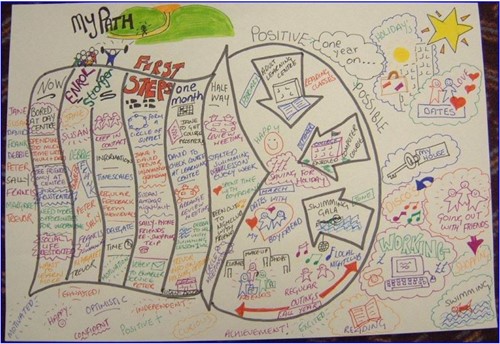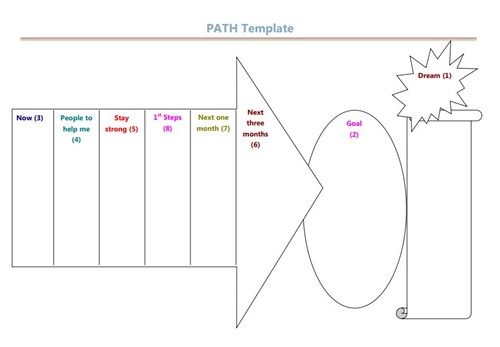For general services, training, communication and resources for schools please go to the Kirklees Business Solutions website.
- Local Offer Home
- SENDCO & Professional information and resources
- Support Plans (I-APDR, MSP's & IEP's)
Person centred planning using the PATH tool.

PATH (Planning Alternative Tomorrows with Hope)
What is it?
PATH is a tool that you can use when the young person has a specific goal or dream for the future, to work out the actions that need to be taken in order to make that happen.
When using PATH, a group of people chosen by the young person get together and use the PATH template and graphic facilitation to develop an achievable and realistic goal for the future based on ‘the dream’ and implements backwards planning to create a step by step path to achieving that goal.
It has a very clear structure and commits people to tasks in a given timescale.
How to use it:
Using a very large sheet of paper with the PATH drawn on it, the group are guided by the facilitator through the process and record the plan in words and pictures.
1. They look first at the person’s dreams. No limits or constraints are placed on the dreams or the ideal future that they illuminate, so that a person can indicate what matters most to him or her. Then, on the basis of the person's dreams and ideal future, specific goals that are both positive and possible are identified.
2. The group then imagine possible and positive achievements/goals that could be made over the next 1-2 years.
3. This is then compared to how their life is ‘now’
4. The group then identify people that they can enrol to help the person get to their goals and what they need to do to stay ‘strong’ and motivated.
5. The group identifies ways to build strength to accomplish the goals (for example, what skills need to be developed or what relationships maintained).
6. They then plan the steps needed to achieve the goals. First they identify long term steps (3-6 months).
7. Then identify shorter term steps (1-3 months)
8. Lastly, the first steps are identified.
A key to this planning process is identifying who will be responsible to do what to help achieve a person's goals. This is a way in which the person him or herself, family members, other community members, and service agencies can make specific commitments to take action. Usually, opportunities to review the pathfinders' goals and update actions are provided.
The template below can be used to complete a PATH:
More guidance can be found in the following document which also has some examples of PATHS:
en-GBLast updated: 11/06/2021

